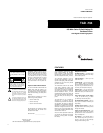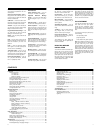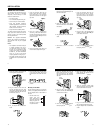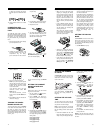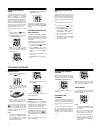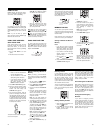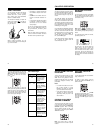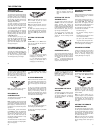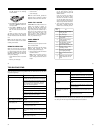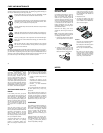
20
USING FLASH
FLASH
performs the electronic equiva-
lent of a switchhook operation for spe-
cial services, such as Call Waitin
g
.
For example, if
y
ou have Call Waitin
g
,
press
FLASH
to answer an incomin
g
call
without disconnectin
g
the current call.
Press
FLASH
a
g
ain to return to the first
call.
Note:
If
y
ou do not have an
y
special
phone services, pressin
g
FLASH
mi
g
ht
disconnect the current call.
USING TONE SERVICES
ON A PULSE LINE
Some special services, such as bank-
b
y
-phone, require tone si
g
nals. If
y
ou
have pulse service,
y
ou can still use
these special tone services b
y
followin
g
these steps.
1. Be sure
DIAL MODE
is set to
P
(pulse).
2. Dial the service’s main number.
3. When the service answers, press
TONE
(). An
y
additional numbers
y
ou dial are sent as tone si
g
nals.
4. After
y
ou complete the call, return
the handset to the base or press
TALK
. The phone automaticall
y
re-
sets to the pulse mode.
Note:
When
y
ou dial a number without
displa
y
ed,
y
ou can enter
TONE
()
as part of the number (the displa
y
shows
). When
y
ou press
TALK
, the phone
automaticall
y
adds a 1-second pause af-
ter the tone entr
y
, allowin
g
time for the
service to answer (for example).
USING PAGE AND FIND
To send a pa
g
e from the base to the
handset, when the handset is not in use,
press
PAGE
on the base. The handset
beeps for 2 seconds and the handset’s
displa
y
shows
PAGING
.
talk
21
If
y
ou have misplaced the handset and
want it to beep for more than 2 seconds
(to
g
ive
y
ou time to find it), press
FIND
.
The handset beeps for about 1 minute.
Press
TALK
twice on the handset to si-
lence the beep sooner.
MEMORY DIALING
You can store up to 20 phone numbers
and names in memor
y
, then dial a stored
number b
y
enterin
g
a two-di
g
it memor
y
location number.
Each number can be up to 16 di
g
its, and
each name can be up to 12 characters.
Storing a Number and Name in
Memory
Notes:
• If
y
ou wait more than 20 seconds
between each ke
y
press, a five-beep
error si
g
nal sounds and memor
y
stora
g
e stops. Start a
g
ain at Step 1.
• If
y
ou receive a call while storin
g
a
memor
y
number,
y
ou must start
a
g
ain from Step 1.
1. Lift the handset. If appears,
press
TALK
to turn it off.
2. Press
FUNCTION
.
DIALMEMORY?
and
MEM-1EDIT-0
appear.
3. Press
1
to store a new number.
PHONE
NO.?
appears.
4. Enter the number and an
y
tone or
pause entries (see “Usin
g
Tone Ser-
vices on a Pulse Line” on Pa
g
e20
and “Enterin
g
a Pause” on
Pa
g
e23).
Note:
Each tone or pause entr
y
us-
es one di
g
it of memor
y
.
5. Press
MEM.
NAME?
appears.
6. To enter a name, use t or s to select
the characters and or to move
the cursor.
Repeatedl
y
press t to see the char-
acters in alphabetical order. (The
displa
y
shows uppercase letters
first, then lowercase letters, num-
bers, and special characters.)
talk
22
Notes:
• Press s to see the characters in
reverse alphabetical order.
• You can hold down s or t to scroll
rapidl
y
throu
g
h the characters.
• If
y
ou make a mistake, move the
cursor over the error, then enter
the correct character, or press
DELETE
to delete a character.
7. Press
MEM
.
LOCATION?
appears.
8. Enter the memor
y
location number
(01–20) where
y
ou want to store the
number. The TAD beeps and
STORING
briefl
y
appears.
9. For each stored number, write the
person’s or compan
y
’s name next to
the appropriate location number on
the supplied memor
y
director
y
stick-
er. (Use a pencil in case
y
ou need to
chan
g
e the number later.) Peel the
backin
g
from the sticker and attach
it to the phone as shown.
To replace a stored number, simpl
y
store
a new one in its place.
Editing or Deleting a Number in
Memory
Note:
If
y
ou chan
g
e
y
our mind while ed-
itin
g
a memor
y
number, press
CANCEL
to stop the process without makin
g
an
y
chan
g
es.
1. Lift the handset. If appears,
press
TALK
to turn it off.
2. Press
FUNCTION
.
DIALMEMORY?
and
MEM-1EDIT-0
appear.
3. Press
0
to select edit.
LOCATION?
appears.
4. Enter the memor
y
location number
(01-20) for the number or name
y
ou
want to edit or delete. The displa
y
shows the location number, name,
and phone number.
Note:
You can scroll throu
g
h the
memor
y
locations b
y
pressin
g
s or t.
5.
To delete the selected number,
hold
down
DELETE
until the handset
beeps and
Nomemory
appears.
To edit the number,
press
MEM
. Re-
peatedl
y
press
DELETE
to delete
some or all of the number, then en-
ter the new number (in reverse or-
der) and press
MEM
a
g
ain.
Note:
To edit the name without edit-
in
g
the number, press
MEM
twice.
To edit the name,
use the s, t, ,
and ke
y
s as described in Step 6
of “Storin
g
a Number and Name in
Memor
y
” on Pa
g
e 21.
6. Press
MEM
.
STORING
briefl
y
ap-
pears.
talk
23
Entering a Pause
In some telephone s
y
stems,
y
ou must
dial an access code (9, for example) and
wait for a second dial tone before
y
ou
can dial an outside number. You can
store the access code with the phone
number. However,
y
ou should also store
a pause after the access code to allow
the outside line time to connect.
To enter a 2-second pause while storin
g
a phone number, press
PAUSE
.
P
ap-
pears. You can add more pause entries
for a lon
g
er pause.
Dialing a Memory Number
1. Lift the handset. Press
TALK
, if nec-
essar
y
, so appears.
2. Press
MEM
and enter the memor
y
location number (01-20) for the
number
y
ou want to dial.
You can also select a memor
y
number
before
y
ou press
TALK
. Press
MEM
,
then enter the desired location number,
or use s and t to scroll throu
g
h the mem-
or
y
locations. The displa
y
shows the lo-
cation number, name, and phone
number. Then press
TALK
.
Chain-Dialing Service Numbers
When callin
g
special services (such as
alternate lon
g
distance or bank-b
y
-
phone), dial the service’s main number
first. Then, at the appropriate place in
the call, press
MEM
and enter the num-
ber for the location where the additional
information is stored.
Testing Stored Emergency
Numbers
If
y
ou store an emer
g
enc
y
service’s
number (police department, fire depart-
ment, ambulance) and
y
ou choose to
test the stored number, make the test
call durin
g
the late evenin
g
or earl
y
mornin
g
hours to avoid peak demand
periods. Also, remain on the line to ex-
plain the reason for
y
our call.
talk



